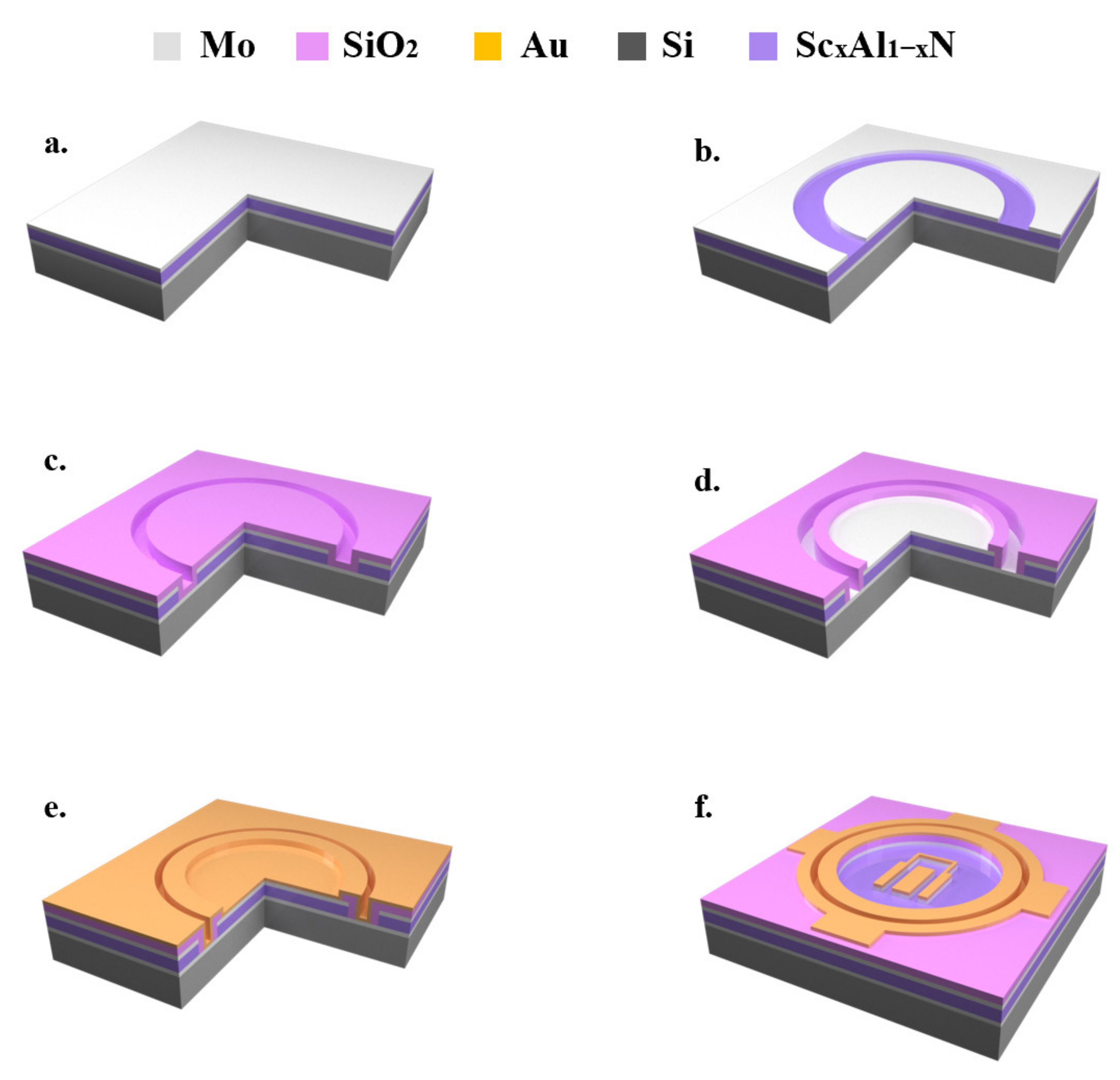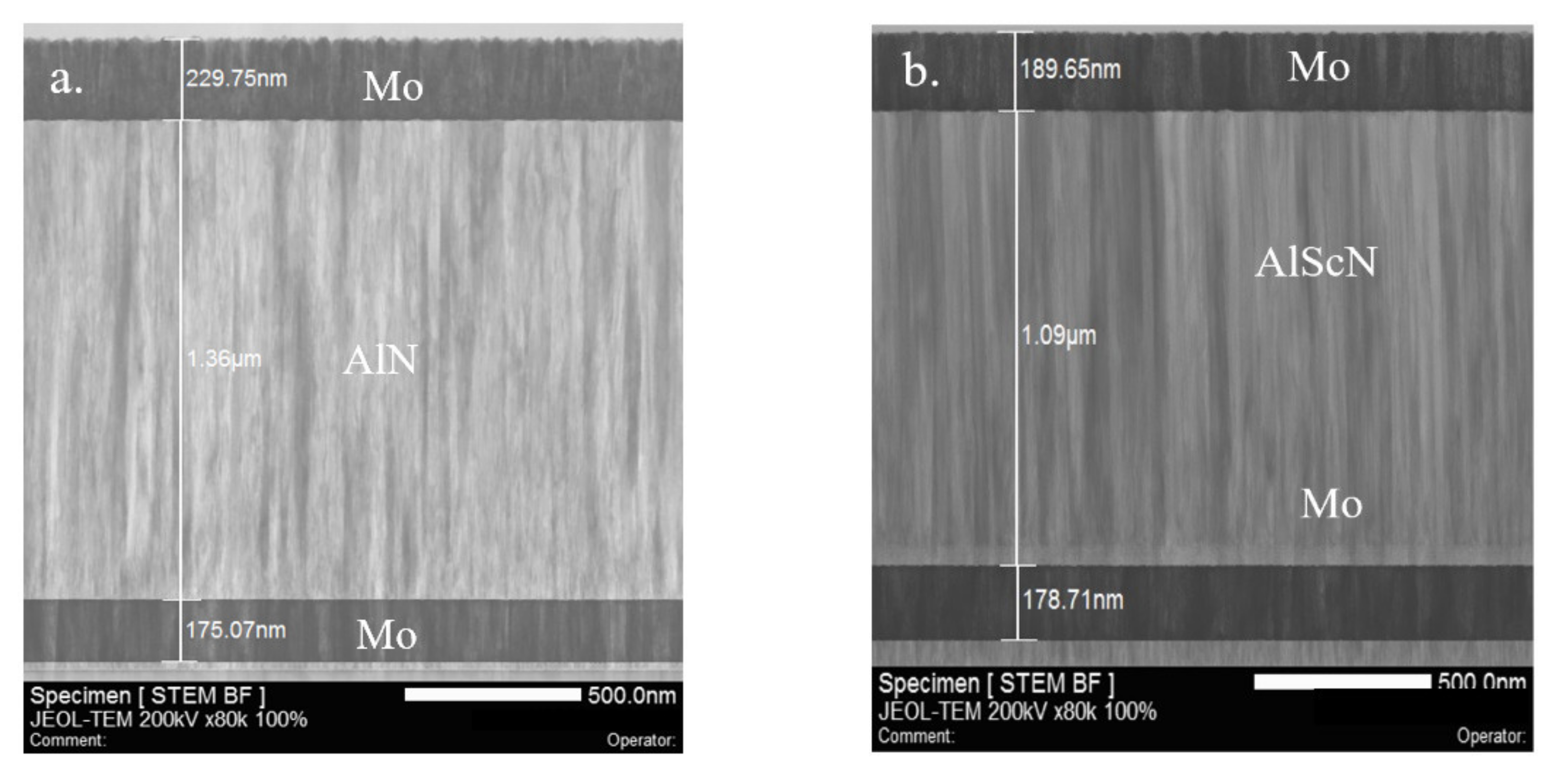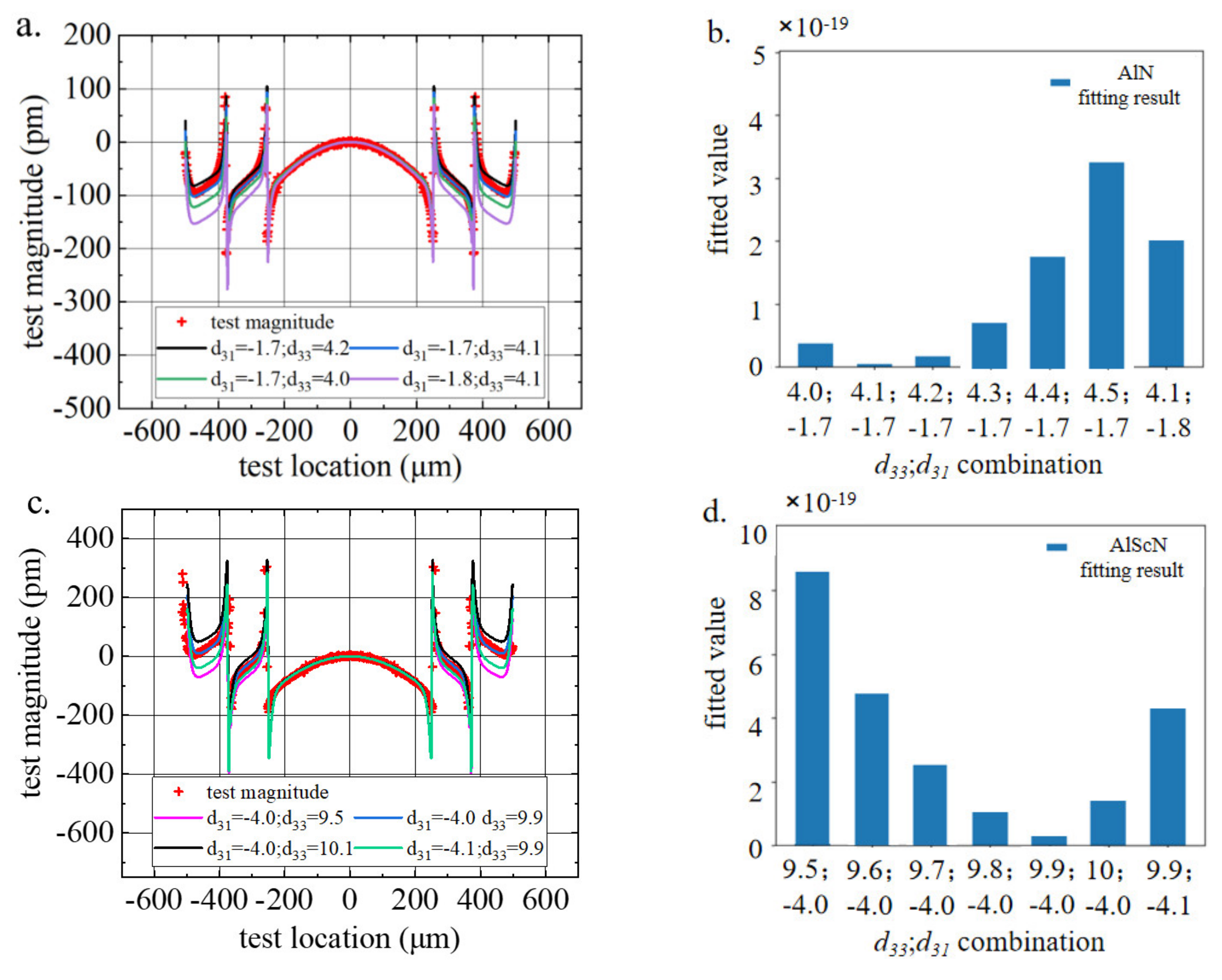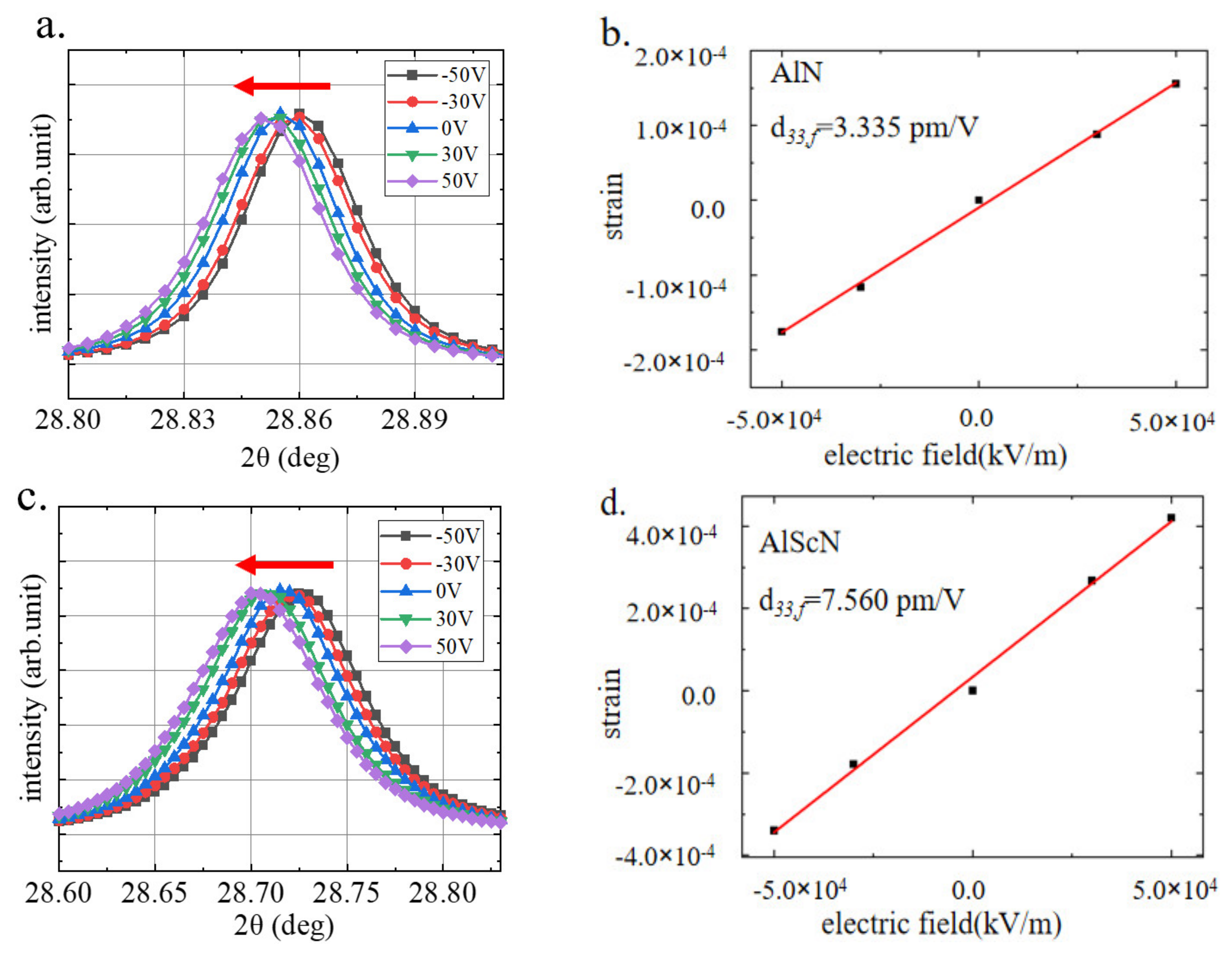Process Control Monitor (PCM) for Simultaneous Determination of the Piezoelectric Coefficients d31 and d33 of AlN and AlScN Thin Films
Abstract
:1. Introduction
2. Materials and Methods
2.1. Preparation
2.2. Physical Analysis
3. Results and Discussion
3.1. Piezoelectric Analysis
3.2. Verification of the Results
4. Conclusions
Supplementary Materials
Author Contributions
Funding
Data Availability Statement
Acknowledgments
Conflicts of Interest
References
- Uehara, K.; Tsubouchi, K. GHz-band acoustic wave device for wireless communication using aluminum nitride film. Rec. Electr. Commun. Eng. Conversazione Tokohu Univ. 2006, 74, 32–35. [Google Scholar]
- Alfadhel, A.; Jing, O.; Cormier, D.; Borkholder, D.A. Enhanced properties of aerosol jet printed PZT: Towards realizing flexible automotive sensors. 2020 IEEE Sens. 2020, 4, 4. [Google Scholar]
- Shin, E.; Yeo, H.G.; Yeon, A.; Jin, C.; Park, W.; Lee, S.C.; Choi, H. Development of a High-Density Piezoelectric Micromachined Ultrasonic Transducer Array Based on Patterned Aluminum Nitride Thin Film. Micromachines 2020, 11, 623. [Google Scholar] [CrossRef] [PubMed]
- Lv, H.; Huang, Y.; Ai, Y.; Liu, Z.; Lin, D.; Cheng, Z.; Jia, L.; Guo, B.; Dong, B.; Zhang, Y. An Experimental and Theoretical Study of Impact of Device Parameters on Performance of AlN/Sapphire-Based SAW Temperature Sensors. Micromachines 2022, 13, 40. [Google Scholar]
- Sun, C.H.; Liu, Y.F.; Li, B.L.; Su, W.Q.; Luo, M.Z.; Du, G.F.; Wu, Y.M. Modeling and Optimization of a Novel ScAlN-Based MEMS Scanning Mirror with Large Static and Dynamic Two-Axis Tilting Angles. Sensors 2021, 21, 2213. [Google Scholar]
- Liu, J.M.; Pan, B.; Chan, H.L.W.; Zhu, S.N.; Zhu, Y.Y.; Liu, Z.G. Piezoelectric coefficient measurement of piezoelectric thin films: An overview. Mater. Chem. Phys. 2002, 75, 12–18. [Google Scholar] [CrossRef]
- Gangidi, P.; Gupta, N. Optimal selection of dielectric film in piezoelectric MEMS microphone. Microsyst. Technol. Micro Nanosyst. Inf. Storage Process. Syst. 2019, 25, 4227–4235. [Google Scholar]
- Iborra, E.; Clement, M.; Sangrador, J.; Sanz-Hervas, A.; Vergara, L.; Aguilar, M. Effect of particle bombardment on the orientation and the residual stress of sputtered AlN films for SAW devices. IEEE Trans. Ultrason. Ferroelectr. Freq. Control 2004, 51, 352–358. [Google Scholar]
- Guenthner, S.; Egretzberger, M.; Kugi, A.; Kapser, K.; Hartmann, B.; Schmid, U.; Seidel, H. Compensation of parasitic effects for a silicon tuning fork gyroscope. IEEE Sens. J. 2006, 6, 596–604. [Google Scholar] [CrossRef]
- Akiyama, M.; Tabaru, T.; Nishikubo, K.; Teshigahara, A.; Kano, K. Preparation of scandium aluminum nitride thin films by using scandium aluminum alloy sputtering target and design of experiments. J. Ceram. Soc. Jpn. 2010, 118, 1166–1169. [Google Scholar] [CrossRef] [Green Version]
- Akiyama, M.; Kamohara, T.; Kano, K.; Teshigahara, A.; Takeuchi, Y.; Kawahara, N. Enhancement of Piezoelectric Response in Scandium Aluminum Nitride Alloy Thin Films Prepared by Dual Reactive Cosputtering. Adv. Mater. 2009, 21, 593. [Google Scholar] [CrossRef]
- Lefki, K.; Dormans, G. Measurement of piezoelectric coefficients of ferroelectric thin films. J. Appl. Phys. 1994, 76, 1764–1767. [Google Scholar] [CrossRef]
- Chun, D.-M.; Sato, M.; Kanno, I. Precise measurement of the transverse piezoelectric coefficient for thin films on anisotropic substrate. J. Appl. Phys. 2013, 113, 044111. [Google Scholar] [CrossRef]
- Campanella, H. Acoustic Wave and Electromechanical Resonators; Concept to Key Applications; IEEE: Piscataway, NJ, USA, 2010. [Google Scholar]
- Hernando, J.; Sanchez-Rojas, J.L.; Gonza?Lez-Castilla, S.; Iborra, E.; Ababneh, A.; Schmid, U. Simulation and laser vibrometry characterization of piezoelectric AlN thin films. J. Appl. Phys. 2008, 104, 053502. [Google Scholar] [CrossRef] [Green Version]
- Kholkin, A.L.; Wutchrich, C.; Taylor, D.V.; Setter, N. Interferometric measurements of electric field-induced displacements in piezoelectric thin films. Rev. Sci. Instrum. 1996, 67, 1935–1941. [Google Scholar] [CrossRef]
- Sivaramakrishnan, S.; Mardilovich, P.; Schmitz-Kempen, T.; Tiedke, S. Concurrent wafer-level measurement of longitudinal and transverse effective piezoelectric coefficients (d(33,f) and e(31,f)) by double beam laser interferometry. J. Appl. Phys. 2018, 123, 014103. [Google Scholar] [CrossRef]
- Mayrhofer, P.M.; Euchner, H.; Bittner, A.; Schmid, U. Circular test structure for the determination of piezoelectric constants of ScxAl1-xN thin films applying Laser Doppler Vibrometry and FEM simulations. Sens. Actuators A-Phys. 2015, 222, 301–308. [Google Scholar] [CrossRef] [Green Version]
- Qi, W.; Lu, Y.; Fung, S.; Jiang, X.; Horsley, D. Scandium Doped Aluminum Nitride Based Piezoelectric Micromachined Ultrasound Transducers. In Proceedings of the Hilton Head Workshop 2016: A Solid-State Sensors, Actuators and Microsystems Workshop, Hilton Head, SC, USA, 5–9 June 2016. [Google Scholar]
- Bernardini, F.; Fiorentini, V. First-principles calculation of the piezoelectric tensor (d)over-left-right-arrow of III–V nitrides. Appl. Phys. Lett. 2002, 80, 4145–4147. [Google Scholar] [CrossRef]
- Mayrhofer, P.M.; Wistrela, E.; Schneider, M.; Bittner, A.; Schmid, U. Precise determination of d(33) and d(31) from piezoelectric deflection measurements and 2D FEM simulations applied to ScxAl1-xN. In Proceedings of the 30th Eurosensors Conference, Budapest, Hungary, 4–7 September 2016; pp. 876–879. [Google Scholar]
- Sivaramakrishnan, S.; Mardilovich, P.; Mason, A.; Roelofs, A.; Schmitz-Kempen, T.; Tiedke, S. Electrode size dependence of piezoelectric response of lead zirconate titanate thin films measured by double beam laser interferometry. Appl. Phys. Lett. 2013, 103, 132904. [Google Scholar] [CrossRef] [Green Version]
- Schmitz-Kempen, T.; Tiedke, S.; Lisec, T.; Stoppel, F.; Mardilovich, P.; Trolier-McKinstry, S.; Sivaramakrishnan, S.; Muralt, P. Comparable Measurements and Modeling of Piezoelectric Thin Films for MEMS application. In Proceedings of the IEEE International Symposium on the Applications of Ferroelectric/Workshop on the Piezoresponse Force Microscopy (ISAF/PFM), Prague, Czech Republic, 21–25 July 2013; pp. 211–213. [Google Scholar]
- Tsubouchi, K.; Mikoshiba, N. Zero-Temperature-Coefficient SAW Devices on AlN Epitaxial Films. IEEE Trans. Sonics 1985, 32, 634–644. [Google Scholar] [CrossRef]
- Umeda, K.; Kawai, H.; Honda, A.; Akiyama, M.; Kato, T.; Fukura, T. Piezoelectric Properties of Scaln Thin Films for Piezo-Mems Devices. In Proceedings of the 26th IEEE International Conference on Micro Electro Mechanical Systems (MEMS), Taipei, Taiwan, 20–24 January 2013; pp. 733–736. [Google Scholar]
- Tan, G.; Maruyama, K.; Kanamitsu, Y.; Nishioka, S.; Ozaki, T.; Umegaki, T.; Hida, H.; Kanno, I. Crystallographic contributions to piezoelectric properties in PZT thin films. Sci. Rep. 2019, 9, 7309. [Google Scholar] [CrossRef]
- Berfield, T.A.; Ong, R.J.; Payne, D.A.; Sottos, N.R. Residual stress effects on piezoelectric response of sol-gel derived PZT thin films. Dep. Theor. Appl. Mech. 2007, 101, 024102. [Google Scholar]
- Dekkers, M.; Boschker, H.; Van Zalk, M.; Nguyen, M.; Nazeer, H.; Houwman, E.; Rijnders, G. The significance of the piezoelectric coefficient d31, eff determined from cantilever structures. J. Micromech. Microeng. 2012, 23, 025008. [Google Scholar] [CrossRef] [Green Version]
- Stoeckel, C.; Kaufmann, C.; Hahn, R.; Schulze, R.; Billep, D.; Gessner, T. Pulsed DC magnetron sputtered piezoelectric thin film aluminum nitride-Technology and piezoelectric properties. J. Appl. Phys. 2014, 116, 034102. [Google Scholar] [CrossRef]








| Material | Range of d31 [pm/V] | Range of d33 [pm/V] | Step Length [pm/V] |
|---|---|---|---|
| AlN | −3.18 to −0.98 | 3.18 to 6.36 | 0.1 |
| AlScN | −5.18 to −2.98 | 5.18 to 10.28 | 0.1 |
| Layer | Material | Thickness [nm] | Gap | Width [μm] |
|---|---|---|---|---|
| 1 | Au | 200 nm | a | 250 μm |
| 2 | Mo | 200 nm | b | 125 μm |
| 3 | AlN/AlScN | 1.36 μm/1.09 μm | c | 125 μm |
| 4 | Mo | 200 nm | / | / |
| 5 | Si | 450 μm | / | / |
| 6 | Al | 2 mm | / | / |
| Material | Property | Value | Units |
|---|---|---|---|
| Anisotropic Si <100> | Young’s modulus | 130 | [GPa] |
| Poisson’s ratio | 0.28 | / | |
| AlN [24] | Young’s modulus | 338 | [GPa] |
| c11 = c22 | 345 | [GPa] | |
| c33 | 395 | [GPa] | |
| c12 | 125 | [GPa] | |
| c13 | 120 | [GPa] | |
| c44 = c55 | 118 | [GPa] | |
| c66 = (c11 − c12)/2 | 110 | [GPa] | |
| s11 = s22 | 3.53 | [10−12 m2/N] | |
| s12 | −1.01 | [10−12 m2/N] | |
| s13 | −0.77 | [10−12 m2/N] | |
| s33 | 3 | [10−12 m2/N] | |
| s44 = s55 | 8.48 | [10−12 m2/N] | |
| s66 | 9.09 | [10−12 m2/N] | |
| Sc0.2Al0.8N [18] | Young’s modulus | 230 | [GPa] |
| c11 = c22 | 325 | [GPa] | |
| c33 | 279 | [GPa] | |
| c12 | 138 | [GPa] | |
| c13 | 131 | [GPa] | |
| c44 = c55 | 99 | [GPa] | |
| c66 = (c11 − c12)/2 | 94 | [GPa] | |
| s11 = s22 | 4.14 | [10−12 m2/N] | |
| s12 | −1.02 | [10−12 m2/N] | |
| s13 | −1.38 | [10−12 m2/N] | |
| s33 | 4.88 | [10−12 m2/N] | |
| s44 = s55 | 10.1 | [10−12 m2/N] | |
| s66 | 10.6 | [10−12 m2/N] |
| Layer | Material | Thickness | Width (W) |
|---|---|---|---|
| 1 | Mo | 200 [nm] | 35 [μm] |
| 2 | AlN (AlScN) | 1.36 [μm] (1.09 [μm]) | 35 [μm] |
| 3 | Mo | 200 [nm] | 35 [μm] |
| 4 | Si | 30 [μm] | 35 [μm] |
| Cantilever Method [pm/V] | In-Situ XRD [pm/V] | LDV-FEM [pm/V] | |
|---|---|---|---|
| AlN d33,f | / | 3.335 | 3.061 |
| AlN d31 | −1.68 | / | −1.7 |
| AlScN d33,f | / | 7.560 | 7.22 |
| AlScN d31 | −3.89 | / | −4.0 |
Publisher’s Note: MDPI stays neutral with regard to jurisdictional claims in published maps and institutional affiliations. |
© 2022 by the authors. Licensee MDPI, Basel, Switzerland. This article is an open access article distributed under the terms and conditions of the Creative Commons Attribution (CC BY) license (https://creativecommons.org/licenses/by/4.0/).
Share and Cite
Zhang, H.; Wang, Y.; Wang, L.; Liu, Y.; Chen, H.; Wu, Z. Process Control Monitor (PCM) for Simultaneous Determination of the Piezoelectric Coefficients d31 and d33 of AlN and AlScN Thin Films. Micromachines 2022, 13, 581. https://doi.org/10.3390/mi13040581
Zhang H, Wang Y, Wang L, Liu Y, Chen H, Wu Z. Process Control Monitor (PCM) for Simultaneous Determination of the Piezoelectric Coefficients d31 and d33 of AlN and AlScN Thin Films. Micromachines. 2022; 13(4):581. https://doi.org/10.3390/mi13040581
Chicago/Turabian StyleZhang, Hao, Yang Wang, Lihao Wang, Yichen Liu, Hao Chen, and Zhenyu Wu. 2022. "Process Control Monitor (PCM) for Simultaneous Determination of the Piezoelectric Coefficients d31 and d33 of AlN and AlScN Thin Films" Micromachines 13, no. 4: 581. https://doi.org/10.3390/mi13040581






